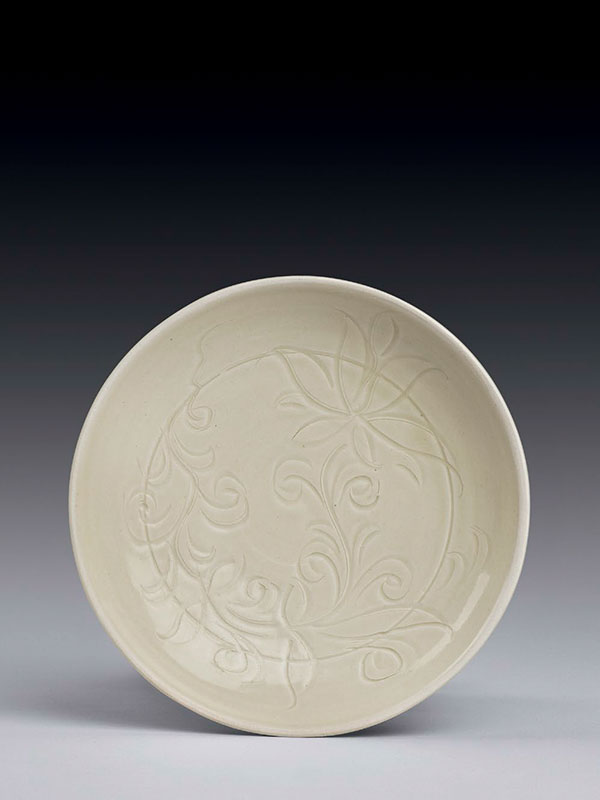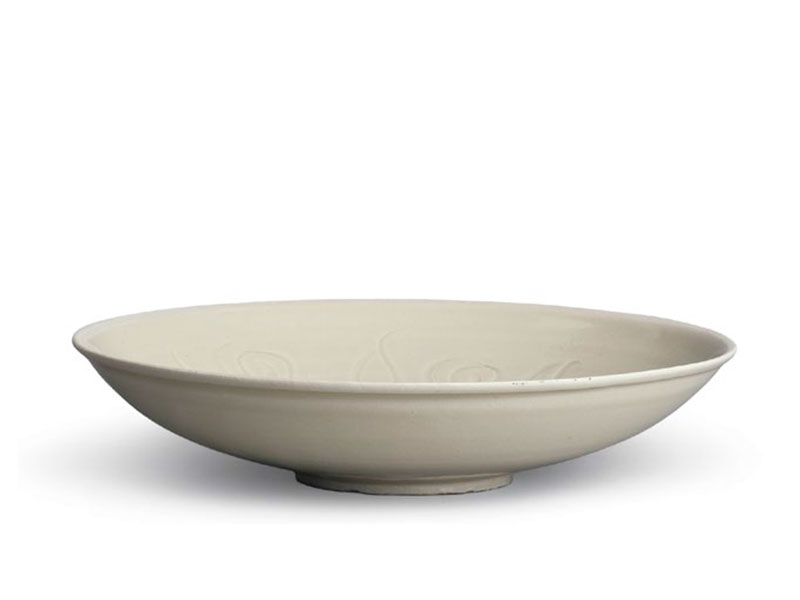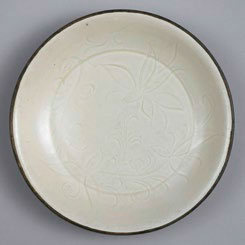Ding porcelain dish
A ding circular porcelain dish, supported on a small ring foot, the thinly potted sides flaring out towards the rim and terminating in a lipped edge. The interior of the dish is carved with a bold design of a daylily amongst scrolling foliage. The centre of the dish is engraved with a circle, which does not completely contain the decoration. The exterior of the dish is plain. The porcelain body is covered in an evenly applied, glossy ivory-coloured glaze, leaving just the outer rim and part of the foot unglazed, where it shows the white porcelain body.
Daylilies (xuancao in Chinese) gained their name for flowering only for one day and are indigenous to Asia where they were originally raised as a food crop; the buds are harvested and eaten, the flowers are used in soups as flavouring, the leaves provide a salad ingredient and the small white tubers in the roots are eaten in a similar way as water chestnuts.[1] The freely drawn decoration of the daylily on the present dish serves not merely as a decorative device but also has various auspicious meanings; it is known in China as wangyoucao, the ‘plant that dispels grief’; yinancao, ‘boy-favouring herb’, where it expresses a wish for male offspring; or it symbolises children’s love towards their mothers. The boldly carved decorations often featured on ding porcelains are a Song innovation, and they mostly have an almost painterly quality. In carving the design, the potter appears to have ignored the central ring that was first carved into the dish. Delicate ding porcelains with dense, high-fired bodies and strong glazes are the precursors of true porcelain. Dishes such as the present example were fired upside-down in the kiln, necessitating the rims to be wiped clean of glaze before firing, to prevent them from becoming stuck to the kiln floor. The resulting unglazed rims of dishes and bowls are brittle, and were therefore often bound in thin strips of metal. A closely comparable ding dish carved with daylily, similar in size and shape, is in the collection of the Palace Museum, Beijing (fig. 1).[2] A smaller ding dish with a daylily, contained within a central circle, is in the collection of Robin and R. Randolph Richmond, Jr.[3] A white stoneware deep bowl with similar carved decoration of daylilies is in the collection of Kai-Yin Lo.[4]
- Welch, P. B. Chinese Art – A Guide to Motifs and Visual Imagery, Tuttle Publishing, 2012, p. 26
- The Palace Museum, Beijing online collection archive: http://www.dpm.org.cn/collection/ceramic/228020.html
- Rotondo-McCord, L. Five Thousand Years of Chinese Ceramics from the Robin and R. Randolph Richmond, Jr. Collection, New Orleans Museum of Art, New Orleans, 2005, pl. 55, p. 80
- Lo, Kai-Yin (ed.) Bright as Silver, White as Snow, Chinese White Ceramics from Late Tang to Yuan Dynasty, Denver Art Museum 1998, pl. 19, pp. 122-3
定窯白釉刻花萱草紋盤
北宋 十 – 十一世紀
徑:17.6 公分 高:3.8 公分
白釉敞口淺盤,下承矮圈足,胎薄質堅,通體施白釉,積釉處呈現白中閃黃的象牙色澤,豐潤細膩。
外壁光素無紋,碗心至內壁刻劃折枝捲葉萱草紋一株。無論器形、花紋或釉色均表現出典型的北宋定
窯產品特徵。此盤採覆燒工藝,即口部向下倒扣裝燒。覆燒時為防止口沿與支圈相黏,因此口沿保持
無釉,骨胎出露,又名「芒口」。其刻花工藝亦為宋金定窯的代表性技法,先用刻刀刻出紋飾的外輪
廓線,再於輪廓線旁劃細線,而另一側斜削減地,刻、劃併用,形成一側雙線,一側斜削的鮮明特
徵。萱草又稱忘憂草或宜男草,於漢朝時已有栽種紀錄,象徵孩子對母親的親情,詩曰:「誰言寸草
心,報得三春暉。」北京故宮博物院藏有一件形制、大小均極為相似的定窯白釉刻花萱草紋盤,惟芒
口處鑲銅釦。香港羅啟妍收藏中則有一件定窯白釉刻萱草紋碗,臺北故宮博物院藏有定窯劃花萱草紋
碟,均可為比較。



